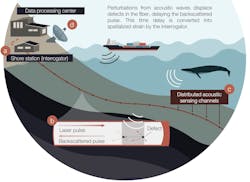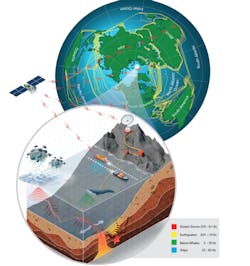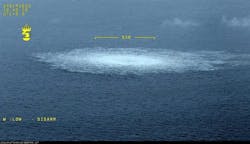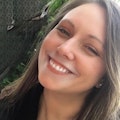There are more than a million kilometers of fiber-optic cable networks around our planet, facilitating internet and data signals and other communications. Other uses are now possible, researchers at the Norwegian University of Science and Technology (NTNU) have discovered.
The team is using distributed acoustic sensing (DAS), a technology that enables continuous, real-time measurements along the entire length of a fiber-optic cable, to see and passively listen to blue and fin whales detected by those cables along the west coast of Svalbard in the Norwegian village of Isfjorden, one of Earth’s northern-most inhabited regions (see Fig. 1 above and video below). This is a world-first.
“We can track several whales simultaneously given that they are vocalizing,” says researcher Martin Landrø, a professor in NTNU’s Department of Electronic Systems who also leads the Center for Geophysical Forecasting. “We think such observations over long periods (months to years) will complement other methods used for whale observations.”
The DAS technique uses what the researchers call an interrogator tool to turn extra, unused fiber in the cable network into an array of hydrophones (underwater devices that detect and record sounds in the ocean from all directions). The method also takes advantage of backscattered laser light, a concept that has evolved over the past several years to submit more laser light.
“This means improved signal-to-noise ratio and longer range, typically 120 km today, for the DAS technology,” Landrø says. “This is a huge step forward to use a cable that is buried below seabed to listen to the whales without any kind of disturbance to the animals.”
The idea of using their technique for arctic and more remote areas stems from the team’s exploration of the DAS technology for whale monitoring. They have been exploring the possibilities and limitations of using DAS technology for geophysical and technological purposes, as well (see Fig. 2).The team wants to use the fiber-optic cable networks to create a real-time ocean-Earth observatory, which would allow them to detect and monitor storms, earthquakes, and even ships. Landrø says the current quality of the signals they’ve been obtaining are far from high-cost hydrophones or seismometers, and the cost benefit and long range—100 km compared to single or groups of conventional sensors—are attractive properties of the evolutionary development of DAS technology.
The researchers have installed fiber-optic cables in an area of Norway that contains quick clay; they plan to measure the clay’s geophysical parameters to monitor any changes over time.
“We focus on new and innovative applications as the sensing technology is developing,” he says (see Fig. 3). “We will test DAS on a 740-m-long bridge crossing a fjord in Norway to monitor eigenfrequencies, which are natural frequencies, and acoustic waves propagating in the bridge.”Perimeter measurement to detect people or animals approaching secured areas is another well-known application of DAS.
The researchers are continuing to study how ship traffic, seismic acquisition, and sonar activity influence marine life, and hope the DAS technology can help avoid ship strikes in the future. They’re also working toward developments related to both signal-to-noise quality and longer ranges. Ultimately, they plan to boost the technology from 120 km to the 1000 km range.
The technique could potentially be used for Lunar applications as well, they say.
“A light fiber might cover longer distances than conventional seismometers, which have been used on the moon since Apollo 11,” Landrø says. “Then the challenge will be to detect ice and measure gravitational waves on the moon.”
FURTHER READING
M. Landrø et al., Sci. Rep., 12, 19226 (2022); https://doi.org/10.1038/s41598-022-23606-x.
About the Author
Justine Murphy
Multimedia Director, Digital Infrastructure
Justine Murphy is the multimedia director for Endeavor Business Media's Digital Infrastructure Group. She is a multiple award-winning writer and editor with more 20 years of experience in newspaper publishing as well as public relations, marketing, and communications. For nearly 10 years, she has covered all facets of the optics and photonics industry as an editor, writer, web news anchor, and podcast host for an internationally reaching magazine publishing company. Her work has earned accolades from the New England Press Association as well as the SIIA/Jesse H. Neal Awards. She received a B.A. from the Massachusetts College of Liberal Arts.



